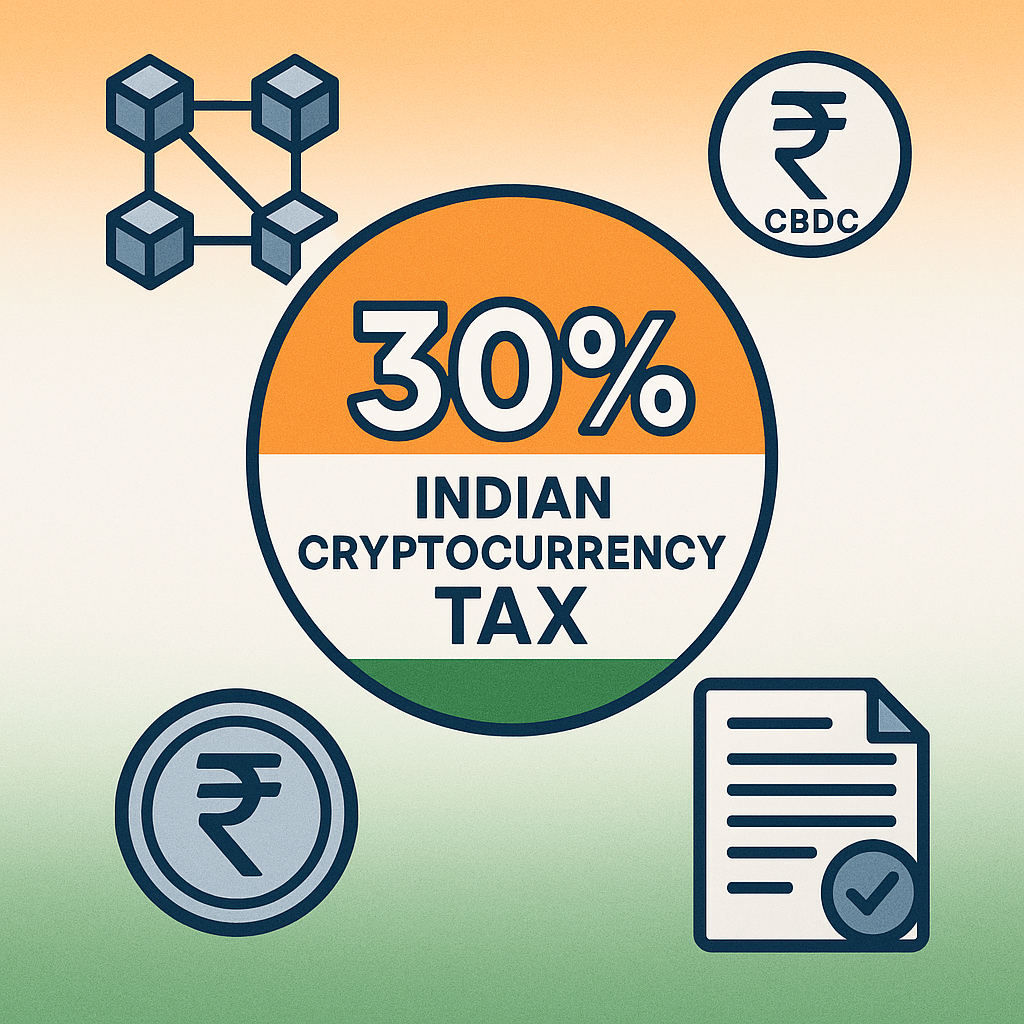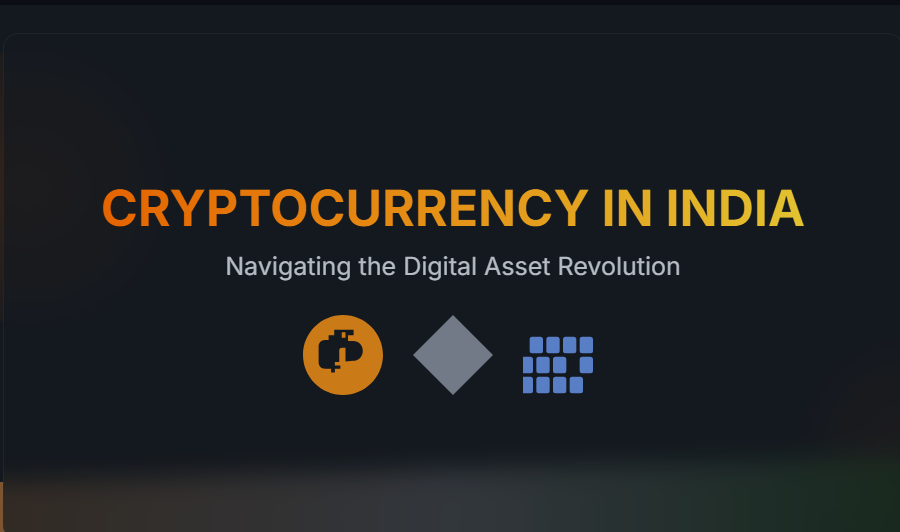Cryptocurrency represents a decentralized digital currency secured by blockchain technology and cryptography, operating without central authority through peer-to-peer transactions. Since Bitcoin’s launch in 2009, India has witnessed surging crypto investments prompting intense regulatory debates balancing innovation with financial stability. The government’s 2022 taxation framework introduced 30% tax on Virtual Digital Assets (VDA) while the RBI pilots CBDC (Digital Rupee) as a sovereign alternative.

Key Highlights
- Heavy taxation regime: India imposes 30% flat tax plus 4% cess on crypto gains with 1% TDS on transactions above ₹10,000-50,000, making it one of the world’s highest crypto tax rates
- Regulatory uncertainty continues: Despite growing adoption, India lacks comprehensive crypto legislation, with the 2021 Cryptocurrency Bill remaining unpassed and leaving legal status ambiguous
- CBDC alternative emerges: RBI’s Digital Rupee (e₹) achieved 1 million daily transactions by December 2023 but usage remains low at 0.006% of total banknotes in circulation
- Global pressure mounting: Following US strategic crypto reserve announcement, India faces increasing pressure to establish clear regulatory framework balancing innovation with risk mitigation
- Blockchain opportunities expand: Beyond currency, blockchain applications in governance, supply chains, DeFi, and Web3 innovation offer significant economic potential despite regulatory constraints
Understanding Cryptocurrency Fundamentals
Blockchain: The Foundation Technology
Blockchain technology serves as the distributed ledger system ensuring transparency, security, and immutability of cryptocurrency transactions.

This decentralized network eliminates the need for central authorities like banks, enabling direct peer-to-peer transactions verified by network participants through cryptographic algorithms.
The blockchain’s key features include:
- Distributed consensus preventing single points of failure
- Cryptographic hashing ensuring transaction integrity
- Immutable records creating permanent transaction history
- Transparency allowing public verification of transactions
Decentralization vs Central Control
Traditional financial systems rely on central banks and governments for currency issuance and transaction validation. Cryptocurrencies operate through decentralized networks where no single entity controls the system, creating resistance to censorship and government interference.
However, this decentralization brings challenges:
- High volatility due to speculative trading
- Regulatory uncertainty across different jurisdictions
- Security risks from hacking and fraud
- Environmental concerns from energy-intensive mining
India’s Cryptocurrency Journey: From Ban to Taxation
Early Regulatory Hostility (2018-2020)
The Reserve Bank of India (RBI) initially prohibited banks from facilitating crypto transactions in 2018, citing concerns about tax evasion, loss of seigniorage income, and fiscal stability risks. This banking ban severely restricted crypto trading until the Supreme Court overturned the restriction in 2020.
The 2020 Supreme Court judgment led to substantial growth in Indian crypto trading, with exchanges like WazirX, CoinDCX, and ZebPay experiencing exponential user growth. Impriindia
Budget 2022: Taxation Framework Introduction
The Union Budget 2022 marked a watershed moment by officially recognizing cryptocurrencies as Virtual Digital Assets (VDAs) and introducing a comprehensive taxation framework: arxiv
Section 115BBH provisions:
- 30% flat tax on crypto gains (highest tax slab in India)
- 4% health and education cess in addition to base tax
- No deductions allowed except cost of acquisition
- No loss offsetting against other gains or income koinx
Section 194S requirements:
- 1% Tax Deducted at Source (TDS) on transactions
- ₹10,000 threshold for general taxpayers
- ₹50,000 threshold for individuals without business income
- Automatic deduction by Indian exchanges cryptact
Current Tax Implications and Compliance
Crypto tax rates in India represent some of the world’s most stringent. The 30% tax plus cess effectively creates a total tax burden of 31.2% on crypto gains. This punitive taxation aims to discourage speculative trading while generating revenue from digital asset transactions. indiafilings
Key compliance requirements:
- ITR-2 form for capital gains reporting
- ITR-3 form for business income from frequent trading
- Schedule VDA for detailed transaction reporting
- Separate disclosure for different crypto activities
RBI’s Digital Rupee: The CBDC Alternative
Development and Implementation
The Digital Rupee (e₹) represents India’s Central Bank Digital Currency (CBDC) using blockchain distributed-ledger technology. Launched December 1, 2022, the e₹ aims to provide a sovereign digital currency alternative to private cryptocurrencies.
Two variants operate simultaneously:
- e₹-W (Wholesale): For interbank settlements and financial institutions
- e₹-R (Retail): For consumer and business transactions rbi
Performance and Adoption Challenges
Despite aggressive targets, CBDC adoption remains disappointingly low. Key statistics reveal:
- 1 million daily transactions achieved by December 2023
- Usage dropped to 100,000 daily transactions by June 2024
- 0.006% of total banknotes in circulation as of late 2024
- ₹323.5 crore total value by May 2024
Major barriers to CBDC adoption include:
- Limited merchant acceptance compared to UPI convenience
- Lack of interest earning on CBDC holdings
- Complex user interface compared to existing payment apps
- Insufficient incentives for consumer adoption
Global Regulatory Landscape Comparison
Diverse International Approaches
Different countries have adopted varying regulatory strategies:
Progressive Frameworks:
- Japan: Legal recognition with comprehensive regulations
- Switzerland: Clear guidelines fostering blockchain innovation
- Singapore: Balanced approach supporting fintech development
- UAE: Crypto-friendly zones attracting international investment
Restrictive Policies:
- China: Complete ban on crypto transactions and mining
- India: Heavy taxation without clear regulatory framework
- Turkey: Payment restrictions while allowing ownership
Evolving Positions:
- United States: Recent strategic reserve announcement boosting global confidence
- European Union: MiCA framework setting global standards
- Vietnam: Swift legal framework introduction following US developments
Concerns and Risk Factors
Financial Stability and Security Issues
Regulatory authorities worldwide express concerns about:
Money Laundering and Terror Financing: FATF red flags highlight crypto’s potential for illicit activities due to pseudonymous transactions and cross-border accessibility.
Consumer Protection Gaps: Lack of investor safeguards, exchange failures, and fraud risks expose retail investors to significant losses without regulatory recourse.
Market Volatility: Extreme price fluctuations create speculative bubbles threatening financial stability and investor wealth.
Environmental Impact: Bitcoin mining and proof-of-work consensus consume massive energy, raising sustainability concerns.
Systemic Risk Considerations
Central banks worry about crypto adoption undermining:
- Monetary policy effectiveness
- Foreign exchange controls
- Banking system stability
- Government revenue collection
The RBI’s cautious stance reflects these systemic concerns, preferring controlled CBDC adoption over private crypto proliferation.
Opportunities in Blockchain Innovation
Governance and Public Administration
Blockchain applications in Indian governance show significant promise:
- Land record management ensuring transparent ownership
- Supply chain tracking for food safety and authenticity
- Digital identity systems reducing documentation fraud
- Voting systems enhancing electoral transparency
Financial Inclusion and DeFi
Decentralized Finance (DeFi) protocols offer revolutionary potential:
- Lending and borrowing without traditional intermediaries
- Cross-border remittances at reduced costs
- Microfinance for unbanked populations
- Automated savings and investment products
Startup Ecosystem and Web3
India’s tech ecosystem increasingly embraces Web3 innovation:
- NFT marketplaces and digital art platforms
- Gaming with blockchain integration
- Decentralized applications (dApps) development
- Crypto exchange and trading platforms
Regulatory Evolution and Future Outlook
Proposed Legislative Framework
The 2021 Cryptocurrency and Regulation of Official Digital Currency Bill aimed to establish comprehensive regulations but failed to pass Parliament, leaving legal status uncertain. Key proposed elements included:
- Classification of permissible vs prohibited activities
- Licensing requirements for crypto service providers
- Investor protection mechanisms
- Integration with existing financial regulations
Multi-Regulator Approach
SEBI’s 2024 proposal suggests a coordinated regulatory framework involving:
- RBI: Monetary policy and systemic risk oversight
- SEBI: Investment products and market conduct
- Ministry of Finance: Taxation and anti-money laundering
- CERT-In: Cybersecurity and technical standards
Pressure for Reform
Growing international adoption, particularly the US strategic reserve announcement, increases pressure on India to clarify crypto regulations. Industry experts recommend:
- Comprehensive crypto regulation bill
- Investor protection mechanisms
- Stablecoin integration with CBDC
- Tax regime reforms preventing capital flight
- Public-private collaboration frameworks
Strategic Recommendations and Way Forward
Balanced Regulatory Approach
India needs a nuanced strategy balancing innovation promotion with risk mitigation:
- Clear legal definitions for different crypto categories
- Proportional regulations based on risk assessment
- Sandbox environments for controlled experimentation
- International coordination on global standards
Tax Policy Reform
The current 30% tax rate may be counterproductive, potentially driving activity underground or to other jurisdictions. Recommendations include:
- Differentiated tax rates based on holding periods
- Loss offsetting provisions similar to other capital assets
- Reduced TDS rates to encourage compliance
- Clearer expense deduction guidelines
Technology and Innovation Support
Blockchain technology adoption should be encouraged through:
- Government procurement of blockchain solutions
- Skill development programs in blockchain technologies
- Research and development funding for indigenous innovation
- Industry-academia partnerships for technology advancement
Conclusion
Cryptocurrency in India represents a complex intersection of technological innovation, regulatory caution, and economic opportunity. The government’s 2022 taxation framework acknowledges crypto’s inevitability while attempting to control its growth through punitive measures.
The Digital Rupee CBDC shows promise as a sovereign alternative but faces adoption challenges compared to existing payment systems. Global developments, particularly US strategic reserves, create pressure for regulatory clarity and competitive positioning.
Blockchain technology’s potential extends far beyond currency applications, offering transformative opportunities in governance, supply chains, and financial services. India’s success will depend on crafting balanced policies that encourage innovation while managing risks.
The future trajectory likely involves gradual regulatory evolution toward greater clarity, reduced tax burdens, and comprehensive frameworks supporting both CBDC adoption and private crypto innovation. Stakeholder collaboration between government, industry, and civil society remains crucial for navigating this digital transformation.
Mains Questions
- Cryptocurrency is seen both as a financial innovation and a systemic risk. Discuss the need for a balanced regulatory framework in India.
- “The rise of blockchain technology could disrupt traditional financial systems.” Critically evaluate.









+ There are no comments
Add yours